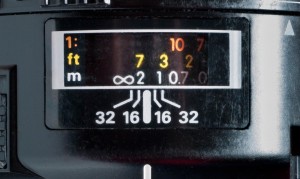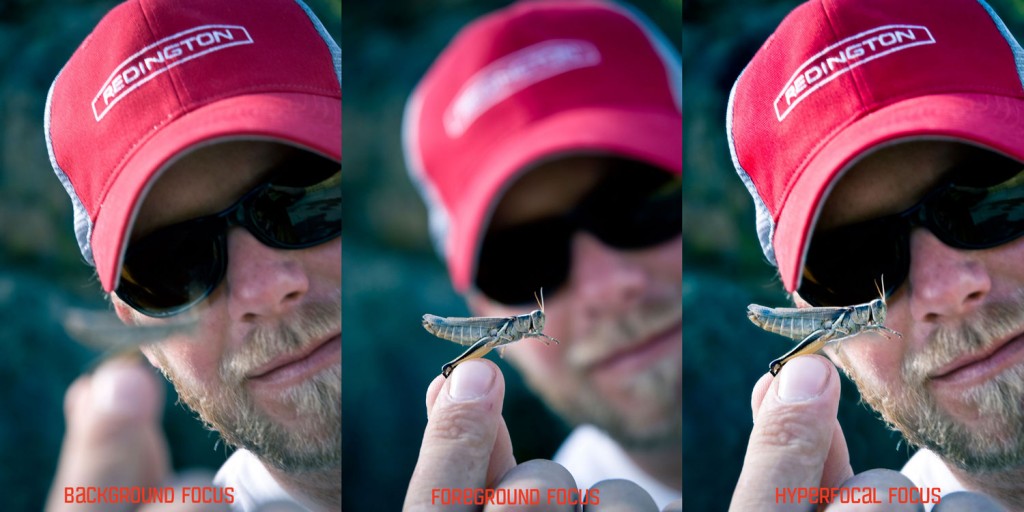Sometimes to get it all in focus, it has to all be out of focus.
Shooting photos you often find yourself wanting an object in the foreground and an object in the background both in focus. This can be a frustrating situation. Inevitably, focusing on either the foreground or the background leaves the other out of focus. There is a way to make it happen but it requires putting on your thinking cap.
 It’s called hyperfocal focus and yes there’s going to be math, sort of. You may have noticed that on the barrel of your DSLR lens there is a scale that shows how far from the camera your point of focus falls. That tool is handier than you might think. Here’s how you use it to get the shot.
It’s called hyperfocal focus and yes there’s going to be math, sort of. You may have noticed that on the barrel of your DSLR lens there is a scale that shows how far from the camera your point of focus falls. That tool is handier than you might think. Here’s how you use it to get the shot.
First focus on the foreground object that you want sharp. At this point it doesn’t matter whether you use auto of manual focus. Take a look at the scale. Let’s say your foreground focus is at three feet. Now focus on the background object that you want sharp. Let’s say it’s at nine feet. We now know we need to carry six feet of focus.
That six feet of sharpness is called depth of field or DOF. Literally the depth of our field of focus. We control the DOF with our aperture. Smaller apertures like F16 or F22 carry a wider DOF. Larger apertures like F2.8 or F4 have narrow DOF. If you’re confused don’t panic. Stay with me. The higher the F# the smaller the aperture. It’s a mathematic formula and I could explain it but it’s not important for this exercise and it’s frankly too much information.
So what we need is an F# that will carry six feet of DOF. Now it’s time to set your camera to manual focus! if you spent a whole lot of money on your lens it may have a scale that shows you the DOF for each F#. If so, that’s great. Choose an F# and set your focus so that three feet and nine feet fall between the brackets. If you don’t have the scale, don’t panic, just set your lens for the highest F#. If you want to get really technical, consult this nifty DOF calculator.
OK, I promised math so here it is. The thing about DOF is it’s a geometric progression. That means that as you increase your DOF by stopping down your aperture, you get twice as much DOF behind your point of focus as you do in front. Does your head hurt yet? Trust me it’s easy. Just divide the the distance you need to carry, in this case six feet by three then add that to the distance to your foreground object.
6′ / 3 = 2′ + 3′ = 5′
The six feet we need to carry divided by 3 plus the three feet to the foreground object equals five feet. Set your focus to five feet and shoot away! Nothing will look sharp in the camera but don’t worry. Have a look at the results and if you don’t quite get it all sharp, take a step back (away from the subject) and do the math again.
All of this takes a minute and it’s hard to pull off with a thrashing fish but under the right circumstance, it can take your photos to the next level. After a while, you will get the hang of it. I often use this technique, short hand, using my auto focus and selecting a point of focus that I feel is one third of the way into my scene. It pays of.
Louis Cahill Gink & Gasoline www.ginkandgasoline.com hookups@ginkandgasoline.com Sign Up For Our Weekly Newsletter!

Sadly most folks just shoot in Program or Automatic. After shooting weddings part time for 29 years using a Hasselblad, light meter and a Metz flash, you’ll figure out DOF pretty quick, especially shooting large groups. Today’s cameras give you lots of flexibility, however, if you poll a hundred people, I’d bet most, maybe greater then 95%, don’t worry about DOF, however it really frames the photos. Then there is the larger sensor DSLR. With two cameras that have very different size sensors you can take photographs that look exactly the same, in terms of Depth of Field and Perspective. A large sensor camera gives you more creative freedom in the ability to isolate your subject from the image background. Then again large price disparity. For me, higher quality faster shooting lenses are more important, esp. action like jumping tarpon etc.
For simple folks there’s the portrait mode which does the same?
Another great posting!
Key points (to obtain greater distance between objects “in focus”):
1) Use the smallest aperture on your lens,
2) “…select a point of focus that… is one third of the way into (the) scene…”
Also note that fish reflect light that is usually 2 or 3 stops brighter than average meter reading. You might want to shoot in manual mode for best results.
While I agree with most of this post I question using the smallest possible aperture. Although shooting at f/16 will give the most DOF it may not give the most sharpness. This is because of the nature of the microlenses used in digital sensors; at the smallest apertures the angle of light being intercepted by the microlenses causes diffraction. Most avid photographers will instead choose to shoot at f/8 rather than f/16- which not only minimises diffraction but usually falls into the “sweet spot” where the lens is also optically sharpest.
Of course, most fisherfolk are more concerned with getting a shot of their fish and friends, not making prints or shooting magazine covers, so it’s not really that important. Finally, most consumer-level point-and-shoot cameras won’t have apertures as small as f/16 anyway. The most important thing is to have fun, not obsess over every little thing!